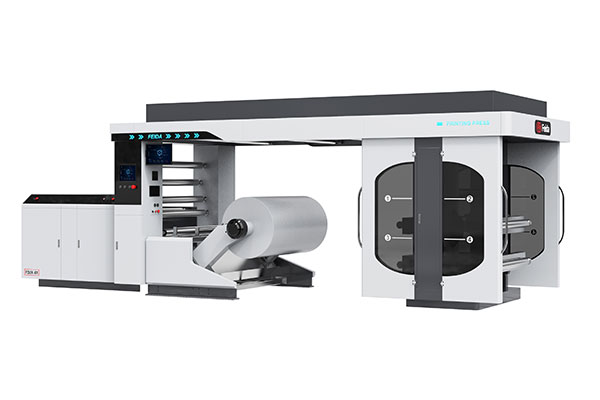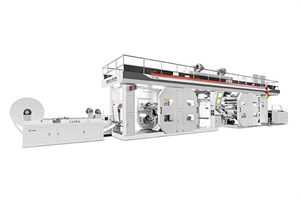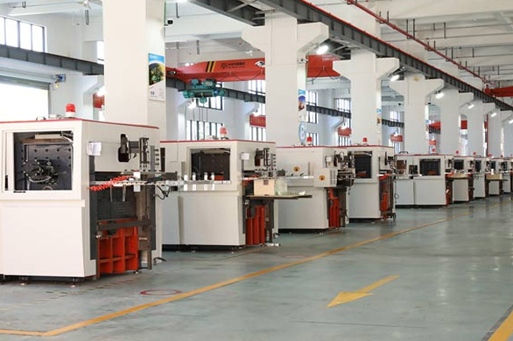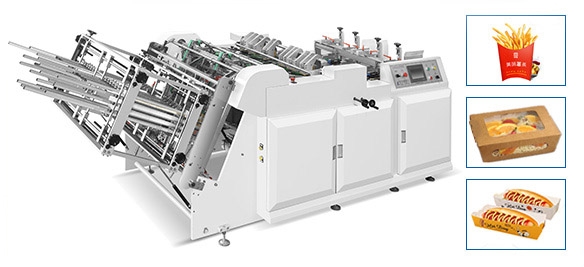CI Flexo Printing Presses
Flexographic printing, commonly known as flexo printing, is a versatile method that utilizes a flexible relief plate to transfer ink onto various substrates. These substrates can include a range of materials such as:
*Films: Polyester, OPP (Oriented Polypropylene), nylon, and PE (Polyethylene)
*Papers
*Carton board
*Non-woven textiles
*Coated or uncoated liner board
Modern flexographic presses use photopolymer plates with a mirror relief image of the desired print. The raised areas of the plate receive ink from an anilox roller and subsequently transfer it onto the substrate.

Types of Flexographic Presses and Their Processes
Flexographic printing machine come in three primary configurations, determined by the arrangement of the printing units, also referred to as printing decks:
Central Impression (CI) Flexo Presses: These presses feature decks arranged around a single, large-diameter impression cylinder.
1. Stack Flexo Presses: These presses have decks stacked vertically, one above the other.
2. In-Line Flexo Presses: In this setup, the print units are aligned horizontally in a single line.
Zhejiang Feida Machinery Ci Flexo Printing Presses
Feida CI flexo presses provide precise control and automation for efficient printing. They feature a 20kg magnetic powder brake and automatic tension control for stable web handling, an auto web guiding system for accuracy, and advanced components like an ink roller, ceramic anilox roller, printing roller, and support roller. The main control panel integrates temperature control, length counting, and speed regulation. The rewinding section includes a 7.5kw motor and inverter clutch for optimal performance.
In a contemporary flexographic press, each print unit is comprised of several key components:
*Anilox Roller: This cylinder, made from high-quality metal or ceramic, is laser-engraved with tiny cells arranged at specific angles, line screens, and volumes to achieve the desired print precision.
*Chambered Doctor Blade System: This device regulates the ink delivery to the anilox roller cells.
*Plate Cylinder: The printing plate is mounted on this cylinder.
*Impression Cylinder: This component supports the substrate as the printing plate presses against it.
*Inking System: This system includes an ink holding tank, ink pump, delivery and return ink lines, and other elements to maintain ink supply and viscosity.
Driers may be installed between print units to ensure that subsequent colors are applied without blending into previously printed ones. These driers can use hot air, infrared, or ultraviolet light, depending on the application.
Printing Process
During the printing process, ink is pumped into the chamber of the doctor blade system. Inside the chamber, the barrier blade and doctor blade seal the ink and restrict its movement while it interacts with the anilox roller. As the anilox roller turns, its cells pick up ink from the chamber. Any excess ink is scraped off by the doctor blade as the roller rotates. The ink is then transferred from the anilox roller to the raised areas of the printing plate mounted on the plate cylinder. Finally, the image is transferred from the plate onto the substrate.
Process Advantages
Flexographic printing offers several advantages, including:
Ink Availability: The most commonly used inks in flexo printing are water-based, which are easier to handle and dry more quickly.
Plate Manufacturing: The production of flexo printing plates is relatively simple and adaptable to a broad spectrum of substrates.
Print Quality and Registration: CI flexo printing is renowned for its high print quality and accurate registration. Recent advancements in in-line flexo presses have enabled them to compete with gravure and lithographic presses, particularly in the production of fiber-board packaging.
Overall
Flexographic printing provides several advantages, such as the use of fast-drying water-based inks, adaptable plate manufacturing, and high-quality print results with accurate registration, making it competitive with other printing methods like gravure and lithography.








